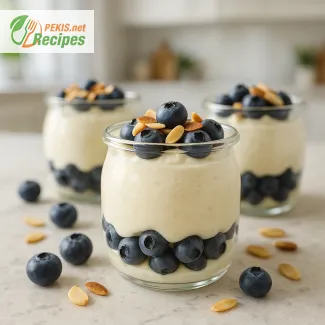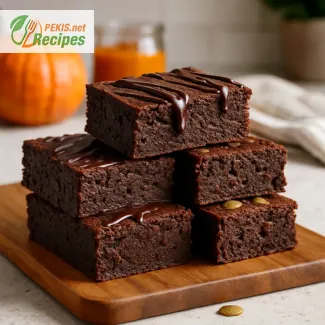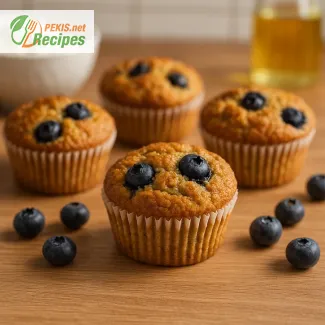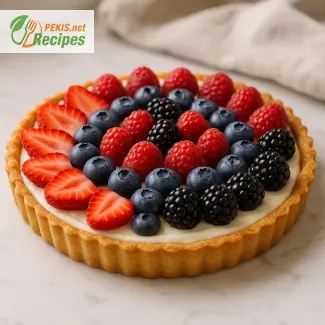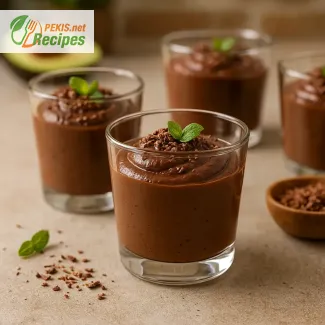
Decadent and Wholesome: A Modern Take on Chocolate Mousse
Discover the perfect vegan dessert with rich flavor and a guilt-free twist
In the world of plant-based desserts, few treats rival the indulgent texture and flavor of a vegan avocado chocolate mousse. This modern classic combines two of the most powerful vegan ingredients—ripe avocado and aquafaba—to create a smooth, airy, and intensely chocolatey dessert that's both dairy-free and eggless. It's a brilliant solution for those seeking a dessert that is not only luxurious and satisfying but also aligned with a plant-based lifestyle.
What sets this dessert apart is its velvety consistency achieved without any cream or butter. The secret lies in the creamy richness of avocado and the light, fluffy structure of whipped aquafaba, the liquid derived from canned chickpeas. Together, these ingredients replicate the mouthfeel of traditional mousse while offering a health-conscious alternative. Whether you're vegan, lactose intolerant, or simply seeking a refined dessert with natural ingredients, this mousse delivers.
Why avocado and aquafaba make the perfect pair
The use of avocado in desserts might sound unusual to some, but its buttery consistency and neutral flavor make it an exceptional base for chocolate creations. When blended with high-quality cocoa powder and a touch of sweetener, avocado lends a silky smooth texture that feels indulgent yet light. It blends seamlessly, allowing the chocolate flavor to shine while contributing essential healthy fats.
Aquafaba, on the other hand, brings the magic of whipped egg whites—without the eggs. When beaten, this chickpea liquid transforms into stiff, glossy peaks, mimicking the structure of meringue. Its ability to hold air makes it an excellent binding and aerating agent for vegan baking and desserts. In this mousse, it lifts the rich chocolate mixture into a light, airy texture, creating the perfect contrast to the density of the avocado base.
A dessert that aligns with clean eating and mindful indulgence
For those who follow a vegan, gluten-free, or refined sugar-free diet, this dessert fits beautifully into a wide range of dietary preferences. It's free from processed ingredients and avoids artificial thickeners or stabilizers. You’re left with a dessert that is as nourishing as it is decadent—an elegant end to any meal or a special treat for any time of day.
Because this recipe relies on natural plant-based ingredients, it’s also a fantastic option for sustainable eating. Using aquafaba means reducing waste by repurposing an ingredient that is often discarded. Avocados, rich in monounsaturated fats, also contribute nutritional value while supporting a creamy mouthfeel, eliminating the need for animal-based creams.
When flavor meets function: ideal for entertaining and everyday cravings
This chocolate avocado mousse is as suitable for casual indulgence as it is for special occasions. It can be piped into elegant glasses for dinner parties or spooned into jars for a quick, satisfying snack. The recipe adapts beautifully to additions like vanilla, espresso, or even a hint of chili for a spicy kick. Its minimalist ingredient list and ease of preparation make it approachable for beginners and seasoned cooks alike.
Presentation can be as elevated or rustic as you like. Garnish it with fresh berries, a sprinkle of shaved dark chocolate, crushed pistachios, or coconut flakes to enhance both the visual appeal and the layered taste experience. Since the base is naturally rich, a small portion goes a long way, making it a satisfying choice for anyone with a sweet tooth.
Crafted for modern diets without compromising taste
In a culinary landscape where more people are seeking alternatives to dairy and eggs, this recipe has emerged as a staple in vegan dessert repertoires. The balance of chocolate intensity, smooth texture, and gentle sweetness makes it appealing to a broad audience—not just those on plant-based diets. It’s also ideal for parents looking to introduce children to healthier desserts, or for those transitioning into a flexitarian or whole-food approach to eating.
This recipe celebrates the fusion of simplicity and sophistication, offering a chocolate experience that’s both indulgent and light. With ingredients you can feel good about, it proves that dessert doesn’t need compromise—it only needs creativity.
Whether served chilled at a dinner gathering or prepared ahead for a week's worth of guilt-free indulgence, this vegan chocolate mousse satisfies on every level: taste, texture, and ethics. The thoughtful use of avocado and aquafaba is more than a culinary trend—it’s a transformation of dessert itself into something nourishing, modern, and unforgettable.
1. Melt the chocolate:
Place the chopped dark chocolate in a heatproof bowl and melt it over a double boiler (or in the microwave in short bursts of 20 seconds, stirring between each). Once fully melted, set aside to cool slightly.
2. Prepare the aquafaba foam:
Pour the aquafaba into a clean mixing bowl. Using a hand mixer or stand mixer, whip the aquafaba on high speed for 6–8 minutes until stiff peaks form (similar to egg whites). The volume should triple, and the foam should be glossy and firm.
3. Blend the avocado base:
In a food processor, combine the ripe avocado, cocoa powder, maple syrup, vanilla extract, lemon juice, and salt. Blend until completely smooth and creamy. Scrape down the sides as needed to ensure no lumps remain.
4. Incorporate the chocolate:
Add the melted (but slightly cooled) chocolate into the avocado mixture. Blend again until fully incorporated and smooth.
5. Fold in the aquafaba:
Gently fold one-third of the whipped aquafaba into the chocolate mixture to lighten it. Then carefully fold in the remaining aquafaba in two more batches using a spatula. Do not overmix to avoid deflating the mousse.
6. Chill and set:
Spoon the mousse into serving glasses or jars. Refrigerate for at least 1 hour before serving to allow the mousse to set and flavors to develop.
7. Serve:
Optionally, garnish with fresh berries, grated dark chocolate, coconut flakes, or crushed nuts before serving.
Elevating Your Vegan Mousse: Smart Tips for Deeper Flavor and Perfect Texture
Unlock advanced techniques to make your avocado chocolate mousse even better
Creating a vegan avocado chocolate mousse with aquafaba is already a brilliant plant-based achievement, but with a few thoughtful tweaks, it can evolve from excellent to exceptional. From adjusting the sweetness and chocolate depth to optimizing texture and presentation, this guide walks through the key changes and ingredient substitutions that enhance both flavor and nutrition, while avoiding common pitfalls. Whether you’re preparing it for a dinner party or just indulging solo, these upgrades bring elegance and confidence to your dessert repertoire.
Choosing the right chocolate makes all the difference
Not all chocolate is created equal, especially in a minimal-ingredient mousse where the chocolate plays the leading role. Opting for high-quality dark chocolate with 70–80% cocoa solids results in a richer, more complex flavor without overwhelming bitterness. Lower-percentage chocolate may add too much sugar and lessen the mousse’s clean finish, while ultra-dark varieties (85% and above) may require more sweetener to balance their intensity.
You can experiment by adding a spoonful of raw cacao powder alongside the dark chocolate for an extra boost of antioxidants and a more pronounced cocoa aroma. Alternatively, using chocolate infused with orange zest, espresso, or sea salt can give the mousse a unique signature twist.
Enhancing texture through fat balance and folding technique
The success of this recipe depends on the balance between creaminess and airiness. Avocados provide the fat and body, while aquafaba contributes the lift. However, folding aquafaba incorrectly can deflate the mousse, making it dense instead of fluffy. Always ensure your aquafaba is whipped to firm peaks and folded gently in stages using a spatula—not stirred or blended—so that the air remains trapped.
Adding a small amount of coconut cream (1–2 tbsp) can improve creaminess without compromising the vegan integrity. This is especially helpful if the avocados are less ripe or slightly fibrous. It also adds a subtle tropical undertone that complements the chocolate beautifully.
Balancing sweetness with natural alternatives
The recipe typically uses maple syrup for sweetness, but variations like date syrup or coconut nectar offer lower glycemic options and deeper caramel notes. Steer clear of refined sugars, which can flatten the mousse’s flavor and disturb the delicate avocado-chocolate balance.
If a lighter flavor is desired, agave syrup is a neutral-tasting alternative. Just remember to adjust quantities, as some sweeteners are more concentrated than others. Tasting as you go is essential, especially if your chocolate is already sweetened.
Adding acidity for flavor contrast
A small amount of lemon juice in the recipe is not just for preservation—it’s also a flavor enhancer. Citrus adds a bright top note that contrasts with the richness of the chocolate. You can refine this further by using orange juice, lime zest, or even a splash of raspberry purée to add complexity and freshness to each spoonful.
Why homemade always tastes better
While plant-based mousse is occasionally available pre-packaged, the homemade version is always superior in terms of texture, ingredient control, and customization. When you make it yourself, you avoid emulsifiers, preservatives, and artificial flavors often found in store-bought versions.
Home preparation also allows for better ingredient quality. Using organic avocados, fair-trade chocolate, and pure vanilla extract ensures a richer, cleaner-tasting dessert that supports ethical sourcing and whole-food values.
Avoiding common mistakes that affect consistency and flavor
One of the biggest mistakes is using under-ripe or overripe avocados. An under-ripe avocado leads to a grainy mousse, while an overripe one can introduce an off-putting flavor or smell. Always use avocados that are just ripe—soft but not mushy, with a vibrant green hue inside.
Another issue is overmixing. Once you’ve added the aquafaba, resist the urge to blend or stir vigorously. Too much agitation will collapse the air structure, making the mousse heavy and dense.
Improper chocolate temperature is also a risk. If the melted chocolate is too hot when combined with the avocado, it can cause separation or slightly cook the avocado, dulling its freshness. Allow the chocolate to cool slightly but not harden before mixing.
Creative add-ins for texture and nutritional boost
While the base recipe is minimal, you can easily build on it with crushed nuts, chia seeds, or rolled oats folded in for texture. A layer of crushed vegan biscuits or granola at the bottom of the serving cup can add crunch and contrast.
Adding a teaspoon of instant espresso powder to the mix intensifies the chocolate flavor, making it darker and more mature. A pinch of cinnamon or cayenne pepper introduces warmth and complexity, perfect for those who enjoy spiced chocolate.
Healthier and seasonal adaptations
This mousse can be transformed seasonally by using pureed roasted pumpkin or sweet potato in place of half the avocado. These ingredients bring a mild sweetness and subtle earthiness while reducing fat content. For summer, a layer of chilled berry compote between mousse layers adds acidity and vibrancy, especially when served in clear glasses.
To lower the overall fat while maintaining structure, blend in silken tofu for part of the avocado. Tofu absorbs chocolate beautifully and delivers a high-protein, low-fat result, ideal for those monitoring fat intake.
This dessert is remarkably flexible, making it not just a pleasure to eat, but a playground for culinary creativity. From professional refinement to home comfort, every variation is an opportunity to elevate flavor and embrace the wholesome elegance of vegan cuisine.
Allergens present in the recipe:
- None of the common allergens (no dairy, eggs, nuts, gluten, or soy).
Gluten:
- This recipe is naturally gluten-free.
Substitution tips for allergens and gluten:
- If using store-bought chocolate, verify it’s gluten-free and allergen-safe (some may contain traces of nuts, soy, or dairy).
- For a sweetener alternative, replace maple syrup with agave syrup or date syrup for lower glycemic index.
Vitamins and minerals per serving (approximate):
- Vitamin E: 3.2 mg – supports skin health and immune function
- Vitamin C: 7 mg – aids in collagen production and antioxidant defense
- Vitamin K: 21 µg – essential for blood clotting and bone metabolism
- Folate: 80 µg – important for cell division and red blood cell formation
- Potassium: 485 mg – helps maintain fluid balance and blood pressure
- Magnesium: 60 mg – supports muscle function and energy production
- Iron: 2.3 mg – contributes to oxygen transport and metabolism
Antioxidants per serving (approximate):
- Flavonoids from cocoa: 150 mg – reduce inflammation, improve heart health
- Lutein from avocado: 0.3 mg – supports eye health and cognitive function
- Phenolic acids from dark chocolate and cocoa powder: 90 mg – protect cells from oxidative stress
- Saponins from aquafaba: trace amounts – contribute to anti-inflammatory and cholesterol-lowering effects
